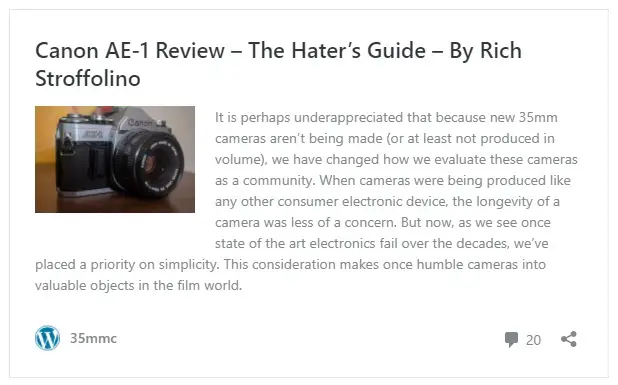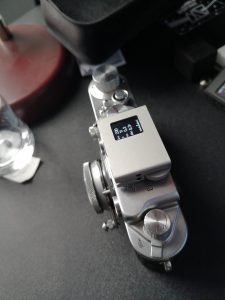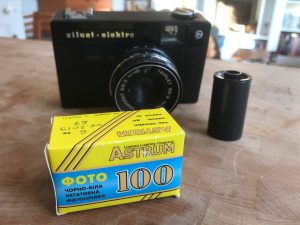This week’s featured post is both funny, but also an accurate review of the Canon AE-1, a camera that seems to cause two very different and very strong opinions depending on who you ask.
I am in the group of those who think the AE-1 is a fine camera but extremely overrated, and this week Rich Stroggolino from 35mmc gives us a brutally honest review of the AE-1, covering it’s ergonomics, viewfinder, and use. Of course, any camera that uses Canon glass is going to be capable of making good pictures, but if the necessity of good pictures is all that’s required of a camera, we’d all be shooting Canon point and shoots.
How a camera matches your style and fits your hands goes a long way, and Rich does an excellent job at covering the camera’s strengths and weaknesses.
 I’ve never done a full review of the AE-1 on this site because I struggle with enough nice things to say about it, so it’s good to see someone hit the nail on the head with almost all of my same opinions about the model.
I’ve never done a full review of the AE-1 on this site because I struggle with enough nice things to say about it, so it’s good to see someone hit the nail on the head with almost all of my same opinions about the model.
In fact, the only area in which I do not agree with Rich is in one of the areas he praises the camera, which is the battery compartment. Sure, it’s great that Canon uses an easy to find, and environmentally friendly 4LR44 battery, but the manner in which the door is designed is incredibly cheap. A large majority of AE-1s out there have broken, or missing doors as it is very easily broken off.
I feel as though the battery compartment is one of the AE-1’s weakest points, and something they could have done better with.
What do you think of Rich’s review? Are you offended at his criticism of your favorite model, or have you stayed away from the AE-1 for the very reasons he mentions?
Here are more great posts from some of my favorite sites:
 I understand why people today want auxiliary meters on old film cameras. Perhaps the meter on the camera you’re using isn’t working or never came with one in the first place, or perhaps you have no confidence in your ability to estimate exposure, but for me, I’ve never really had much of a desire to get one. That might change though with the recently released Hedeco Lime One by Light Engineering. This modern meter reviewed by Alan at Canny Cameras, uses an attractive, low profile, aluminum body with a bright LCD screen that measures exposures in a variety of ways. It doesn’t look entirely out of place on a Barnack Leica like other meters do. It’s a bit expensive, but worth it for those of you who absolutely need an external meter, but care about looks too.
I understand why people today want auxiliary meters on old film cameras. Perhaps the meter on the camera you’re using isn’t working or never came with one in the first place, or perhaps you have no confidence in your ability to estimate exposure, but for me, I’ve never really had much of a desire to get one. That might change though with the recently released Hedeco Lime One by Light Engineering. This modern meter reviewed by Alan at Canny Cameras, uses an attractive, low profile, aluminum body with a bright LCD screen that measures exposures in a variety of ways. It doesn’t look entirely out of place on a Barnack Leica like other meters do. It’s a bit expensive, but worth it for those of you who absolutely need an external meter, but care about looks too.
It’s no secret I love panoramic cameras. I’ve looked at the Kodak No.1 Panoram and the Hasselblad XPan and have a few more reviews coming up, but whenever someone writes about another panoramic camera, you know it’s going to grab my attention and this week Dan Cuny writes about a panoramic camera I’ve never heard of, the Baby Al-Vista camera made by The Multiscope & Film Company. This swinging lens box camera dates from the late 1800s and is very similar to the Kodak Panoram in use. Dan gives a bit of history about the company that made it, some thoughts on it’s use, and of course, some sample images. This is hardly a camera that most people will be able to just load up eBay and buy, but you bet that if one ever comes my way at a nice price, it’ll be hard to pass it up!
As he often does, Alex Luyckx often pairs a short blog post with a release of a new Classic Camera Revival podcast, and this time, episode 89 is devoted entirely to Mamiya medium format cameras. We’re talking about the Mamiyas Universal, C220F, RB67, M645, and 645 Pro. If you enjoy weightlifting while shooting photography, each of these cameras are perfect for you! For as heavy as they are, these are all wonderful photographic tools, and a reminder that I desperately need to get my M645 out!
If you live in the United States and frequent estate and garage sales, there are a few cameras you’ll see over and over again. One of those cameras is the Kodak Hawkeye Brownie, a distinct looking simple box camera made by Kodak in what I assume is the millions. This inexpensive and simple 620 camera was a favorite of American families in the mid 20th century, and for as common as they are, not too many people shoot them, but thankfully, Alyssa from Aly’s Vintage Camera Alley isn’t most people and she loaded up her Hawkeye Brownie and took it out for a spin!
One of the most distinct looking cameras ever made is the Universal Mercury II. This camera was made by a company who had experience making motion picture cameras and took their knowledge and put it to good use in a still camera with a rotary shutter with a distinct hump on the top of the camera, not unlike that of a parking meter. These cameras are pretty easy to find here in the US, but not so much overseas, but thankfully Peggy Marsh from Camera Go Camera got her hands on one and put it through it’s paces. She came away impressed, loving the look of the camera and the sharpness of some of the images. Was it enough to stay in her permanent collection though, you’ll need to read her review to find out!
It’s one of the most popular of all Soviet rangefinders, and for good reason, the Zorki 4 has a ton of things going for it. Generally good build quality, compatibility with a huge selection of M39 lenses, a wide range of shutter speeds, and an excellent viewfinder. This week Caleb Snyder Dicesare from Kosmo Foto gives us a review of his recently repaired and reskinned Zorki 4, admits it not having a Leica level of refinement, but it also doesn’t have a Leica level price tag, and is perhaps one of the best budget interchangeable lens rangefinders out there.
Last month, Alex Luyckx took a look at slow speed Film Washi S, a black and white sound recording film that rates at ASA 50 for photography. This week, he follows up that post with Film Washi D, the same kind of film, but rated much faster, at ASA 500. Both films were developed as an audio recording film that also works as a photographic film, although with some interesting side effects. For one, the base is incredibly thin, which makes it both fragile and difficult to load into development tanks, but also, it is a high contrast film that can make a single image both over and under exposed within the same images, so metering is really important. But if there’s one person who is perfect to review a specialized film like this, it’s Alex!
 Shooting cameras made in the former Soviet Union can be a lot of fun, but when I use my FSU cameras, I have them loaded with some kind of Kodak or Fuji film. The closest I’ve ever come to shooting a Soviet camera with Soviet-era film was one time I shot some old OWRO NP55, but never anything Ivan Drago and his comrades might have used. This week’s article from Kosmo Foto highlights an old Soviet Smena film that has been re-released under the brand name Astrum. This 100 speed black and white film is said to be the same formula used for decades in Zorkis, Zenits, and FEDs, and performs quite well too. Thankfully, it has US distribution through Freestyle Photographic (although as I write this, it’s on backorder), making it affordable. The next time I place a film order, I may just have to pick some up.
Shooting cameras made in the former Soviet Union can be a lot of fun, but when I use my FSU cameras, I have them loaded with some kind of Kodak or Fuji film. The closest I’ve ever come to shooting a Soviet camera with Soviet-era film was one time I shot some old OWRO NP55, but never anything Ivan Drago and his comrades might have used. This week’s article from Kosmo Foto highlights an old Soviet Smena film that has been re-released under the brand name Astrum. This 100 speed black and white film is said to be the same formula used for decades in Zorkis, Zenits, and FEDs, and performs quite well too. Thankfully, it has US distribution through Freestyle Photographic (although as I write this, it’s on backorder), making it affordable. The next time I place a film order, I may just have to pick some up.
Saving the best for last, a while back, Jim Grey sent me a bulk loader with a remnant of Kodak Panataomic-X film in it and I encouraged him to give it a go and he said he didn’t have the time to bulk load his own film, so he sent it to me. Returning his generosity, I loaded up two rolls of it and sent it back to him demanding that he give it a try, and this week, Jim finally posts the results of one of those rolls shot in a Pentax ME. Jim followed my “not so specific” instructions and shot the film pretty close to box speed, and made absolutely no concessions in development, and as I promised, this 30+ year old film delivered! Kodak Pan-X is definitely my favorite black and white film ever, but perhaps I shouldn’t have introduced Jim to it, as now I’ll have more competition trying to snap up remaining stock online!
If you’re looking for something new to watch and you have access to the Disney+ streaming service, I recommend checking out a new miniseries called “The Right Stuff”. Based on Tom Wolfe’s best-selling 1979 book of the same name, the Right Stuff tells the story of the seven American astronauts picked by NASA to lead the Mercury space missions in the race to put the first man in space.
The entire series will be eight episodes, only three of which have aired (the fourth airs tonight, October 23rd) but so far has proven to be not only entertaining, but inspirational.
As an American citizen, with our Presidential election a couple weeks away, I’ve seen my country more divided than I’ve ever seen it before. The United States has never been perfect, but we were once a country that generally had it’s shit together, there was more right about America than wrong.
That isn’t the case today.
America is broken, and I’m not sure either result of the November election will fix that, so this was a nice distraction to see this series and be reminded of a time when Americans truly were united in their desire to be the first at something. There was once a time when America did have it’s shit together, and this series is a good reminder of what we’ve lost.
Putting aside the lens that 2020 shines upon this series, it’s still an entertaining watch for anyone whose a fan of space travel, and for the camera collector, there are a good number of Graflexes, Rolleiflexes, and in episode 2, I even saw an Argus C3! I’ll definitely keep my eyes peeled throughout the rest of the episodes to see what other cameras I can name!


